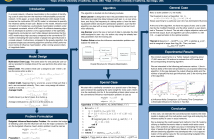

- Read more about Low-Rank Optimization for Data Shuffling in Wireless Distributed Computing
- Log in to post comments
Wireless distributed computing presents new opportunities to execute intelligent tasks on mobile devices for low-latency applications, by wirelessly aggregating the computation and storage resources among mobile devices. However, for low-latency applications, the key bottleneck lies in the exchange of intermediate results among mobile devices for data shuffling. To improve communication efficiency therein, we establish a novel interference alignment condition by exploiting the locally computed intermediate values as side information.
- Categories:
 74 Views
74 Views
Predicting the geographical location of users on social networks like Twitter is an active research topic with plenty of methods proposed so far. Most of the existing work follows either a content-based or a network-based approach. The former is based on user-generated content while the latter exploits the structure of the network of users. In this paper, we propose a more generic approach, which incorporates not only both content-based and network-based features, but also other available information into a unified model.
- Categories:
 16 Views
16 Views
This work develops an effective distributed algorithm for the solution of stochastic optimization problems that involve partial coupling among both local constraints and local cost functions. While the collection of networked agents is interested in discovering a global model, the individual agents are sensing data that is only dependent on parts of the model. Moreover, different agents may be dependent on different subsets of the model. In this way, cooperation is justified and also necessary to enable recovery of the global information.
- Categories:
 8 Views
8 Views
- Read more about Robust Distributed Gradient Descent with Arbitrary Number of Byzantine Attackers
- Log in to post comments
Due to the grow of modern dataset size and the desire to harness computing power of multiple machines, there is a recent surge of interest in the design of distributed machine learning algorithms. However, distributed algorithms are sensitive to Byzantine attackers who can send falsified data to prevent the convergence of algorithms or lead the algorithms to converge to value of the attackers' choice. Our novel algorithm can deal with an arbitrary number of Byzantine attackers.
- Categories:
 16 Views
16 Views
- Read more about Common and Individual Feature Extraction using Tensor Decompositions: A Remedy for the Curse of Dimensionality?
- Log in to post comments
A novel method for common and individual feature analysis from exceedingly large-scale data is proposed, in order to ensure the tractability of both the computation and storage and thus mitigate the curse of dimensionality, a major bottleneck in modern data science. This is achieved by making use of the inherent redundancy in so-called multi-block data structures, which represent multiple observations of the same phenomenon taken at different times, angles or recording conditions.
- Categories:
 30 Views
30 Views
We consider the problem of joint source and channel coding of structured data such as natural language over a noisy channel. The typical approach inspired by information theory to this problem involves performing source coding to first compress the text and then channel coding to add robustness while transmitting across the channel; this approach is optimal with arbitrarily large block lengths for discrete memoryless channels.
- Categories:
 74 Views
74 Views
- Read more about PRIMA: PROBABILISTIC RANKING WITH INTER-ITEM COMPETITION AND MULTI-ATTRIBUTE UTILITY FUNCTION
- Log in to post comments
PRIMA4.pdf
- Categories:
 12 Views
12 Views
- Read more about Streaming Influence Maximization in Social Networks based on Multi-Action Credit Distribution
- Log in to post comments
In a social network, influence maximization is the problem of identifying a set of users that own the maximum influence ability across the network. In this paper, a novel credit distribution (CD) based model, termed as the multi-action CD (mCD) model, is introduced to quantify the influence ability of each user. Compared to existing models, the new model can work with practical datasets where one type of action is recorded for multiple times. Based on this model, influence maximization is formulated as a submodular maximization problem under a knapsack constraint, which is NP-hard.
- Categories:
 13 Views
13 Views
- Categories:
 28 Views
28 Views